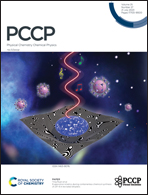Rate constant and branching ratio of the reaction of ethyl peroxy radicals with methyl peroxy radicals
Abstract
The cross-reaction of ethyl peroxy radicals (C2H5O2) with methyl peroxy radicals (CH3O2) (R1) has been studied using laser photolysis coupled to time resolved detection of the two different peroxy radicals by continuous wave cavity ring down spectroscopy (cw-CRDS) in their AÖ![[X with combining tilde]](https://www.rsc.org/images/entities/char_0058_0303.gif) electronic transition in the near-infrared region, C2H5O2 at 7602.25 cm−1, and CH3O2 at 7488.13 cm−1. This detection scheme is not completely selective for both radicals, but it is demonstrated that it has great advantages compared to the widely used, but unselective UV absorption spectroscopy. Peroxy radicals were generated from the reaction of Cl-atoms with the appropriate hydrocarbon (CH4 and C2H6) in the presence of O2, whereby Cl-atoms were generated by 351 nm photolysis of Cl2. For different reasons detailed in the manuscript, all experiments were carried out under excess of C2H5O2 over CH3O2. The experimental results were best reproduced by an appropriate chemical model with a rate constant for the cross-reaction of k = (3.8 ± 1.0) × 10−13 cm3 s−1 and a yield for the radical channel, leading to CH3O and C2H5O, of (ϕ1a = 0.40 ± 0.20).
electronic transition in the near-infrared region, C2H5O2 at 7602.25 cm−1, and CH3O2 at 7488.13 cm−1. This detection scheme is not completely selective for both radicals, but it is demonstrated that it has great advantages compared to the widely used, but unselective UV absorption spectroscopy. Peroxy radicals were generated from the reaction of Cl-atoms with the appropriate hydrocarbon (CH4 and C2H6) in the presence of O2, whereby Cl-atoms were generated by 351 nm photolysis of Cl2. For different reasons detailed in the manuscript, all experiments were carried out under excess of C2H5O2 over CH3O2. The experimental results were best reproduced by an appropriate chemical model with a rate constant for the cross-reaction of k = (3.8 ± 1.0) × 10−13 cm3 s−1 and a yield for the radical channel, leading to CH3O and C2H5O, of (ϕ1a = 0.40 ± 0.20).

- This article is part of the themed collection: 2023 PCCP HOT Articles


 Please wait while we load your content...
Please wait while we load your content...